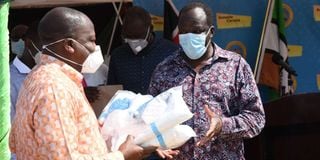Premium
After 5 months, virus response a tale of more misses than hits

What you need to know:
- On March 31, President Uhuru Kenyatta directed Treasury to set up an emergency response kitty for Covid-19.
- The fund would later be used to provide personal protective equipment (PPE) to health workers.
- Crooked officials ensured that Covid-19 funds were either diverted, misapplied, or misappropriated.
It’s been five months now, and Kenya’s Covid-19 experience has largely been one of tragic failure.
Barely days after the first case was confirmed on March 13, Health Cabinet Secretary Mutahi Kagwe and the National Emergency Response Committee unveiled a response strategy.
Days later, he gazetted tough health measures, which have formed the backbone of the country’s fight against the virus, even as the security agencies struggled to enforce them.
On March 31, President Uhuru Kenyatta directed Treasury to set up an emergency response kitty for Covid-19. The fund would later be used to provide personal protective equipment (PPE) to health workers.
Mass testing
As the cases rose in April to 81, the Health ministry prioritised targeted mass testing to map out the hotspots. It prevailed upon the President to put specific areas under lock-down, even as it pushed for targeted mass testing on these areas.
Faced with the reality that the healthcare system would be overrun, President Kenyatta directed Treasury in May to release emergency funds to the counties, as they ramped up their preparedness.
At the start of June and with 2,021 cases, the strategy had started crumbling. Backlogs started becoming the order of the day, which also saw the government fall short of its target to test 250,000 people by the end of June.
How did we end up in this mess?
Well, in May, crafty state officials decided to pinch some of the donations from Chinese tycoon Jack Ma, creating artificial shortage of kits and reagents.
Funds diverted
Crooked officials ensured that Covid-19 funds were either diverted, misapplied, or misappropriated, with fingers pointed at the cartels within the Ministry of Health, Kemsa, and the counties.
As the cases tripled to over 6, 081 at the start of July, the Health ministry ruled out mass target testing. It was clutching at straws as it could not show how widespread the virus was.
The ministry was also struggling with contact tracing.
Even before this, the strategy was barely working due to lack of funds and the necessary technology.
At the end of July, the jury was out. Almost 13, 000 were yet to be traced, even as its Covid-19 infections tripled within the month to 20, 363 cases.
“This strategy was working in the initial stages because there were few chains of transmission. However, as the cases kept rising especially in the rural areas, it became hard to do effective contact tracing,” Dr Majid Twahir, the associate dean for clinical affairs and chief of staff at Aga Khan University Hospital said.
It also emerged that the counties had lied about their preparedness thus allowing the President to reopen the country, yet their health systems were nowhere close to handling any surge in infections.





